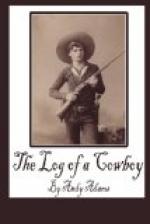Lovell and Flood were a good team of cowmen. The former, as a youth, had carried a musket in the ranks of the Union army, and at the end of that struggle, cast his fortune with Texas, where others had seen nothing but the desolation of war, Lovell saw opportunities of business, and had yearly forged ahead as a drover and beef contractor. He was well calculated to manage the cattle business, but was irritable and inclined to borrow trouble, therefore unqualified personally to oversee the actual management of a cow herd. In repose, Don Lovell was slow, almost dull, but in an emergency was astonishingly quick-witted and alert. He never insisted on temperance among his men, and though usually of a placid temperament, when out of tobacco—Lord!
Jim Flood, on the other hand, was in a hundred respects the antithesis of his employer. Born to the soil of Texas, he knew nothing but cattle, but he knew them thoroughly. Yet in their calling, the pair were a harmonious unit. He never crossed a bridge till he reached it, was indulgent with his men, and would overlook any fault, so long as they rendered faithful service. Priest told me this incident: Flood had hired a man at Red River the year before, when a self-appointed guardian present called Flood to one side and said,—“Don’t you know that that man you’ve just hired is the worst drunkard in this country?”
“No, I didn’t know it,” replied Flood, “but I’m glad to hear he is. I don’t want to ruin an innocent man, and a trail outfit is not supposed to have any morals. Just so the herd don’t count out shy on the day of delivery, I don’t mind how many drinks the outfit takes.”
The next morning after going into camp, the first thing was the allotment of our mounts for the trip. Flood had the first pick, and cut twelve bays and browns. His preference for solid colors, though they were not the largest in the remuda, showed his practical sense of horses. When it came the boys’ turn to cut, we were only allowed to cut one at a time by turns, even casting lots for first choice. We had ridden the horses enough to have a fair idea as to their merits, and every lad was his own judge. There were, as it happened, only three pinto horses in the entire saddle stock, and these three were the last left of the entire bunch. Now a little boy or girl, and many an older person, thinks that a spotted horse is the real thing, but practical cattle men know that this freak of color in range-bred horses is the result of in-and-in breeding, with consequent physical and mental deterioration. It was my good fortune that morning to get a good mount of horses,—three sorrels, two grays, two coyotes, a black, a brown, and a grulla. The black was my second pick, and though the color is not a hardy one, his “bread-basket” indicated that he could carry food for a long ride, and ought to be a good swimmer. My judgment of him was confirmed throughout the trip, as I used him for my night horse and when we had swimming rivers to ford. I gave this black the name of “Nigger Boy.”




